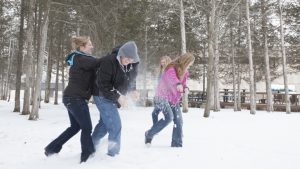
Here’s a guide on how to dress for the weather each month in the Bay of Quinte region...
December/January/February: These are the winter months and the temperature can dip down below -30 degrees celsius. Typical days are around -10 degrees. Winter clothing is necessary (heavy jacket, boots, gloves and hats) especially for enjoying outdoor activities like skiing, tobogganing and skating. Snow tires are recommended for your car to help you drive safely in the slippery winter months.
March: Temperatures are more moderate and usually above zero. Winter clothing is still needed early in the month with medium weight clothing later in the month. The kids are off for a week from school and anxious to get out and play now that the snow is gone. We set the clocks back an hour for Daylight Savings Time in early March.
April: Temperatures in the daytime are more moderate (usually in the 5-10 degrees range) but cool down in the evening. Lighter jackets and sweaters are worn now. We usually see more rainy days in April and May so rubber boots, nylon jackets and umbrellas are helpful.
May: Warmer days (10-15 degrees) but still cool at night. Medium weight and summer clothing are recommended. The trees and landscape is starting to turn green again and the daylight is hanging around a little longer.
June: Warm (15-20 degrees). Summer clothing including shorts, t-shirts and golf/short-sleeve dress shirts. The weather in June is ideal for travel and all outdoor activities. School ends in late June for elementary and high school students.
July/August: These are the warmest months of the year (average 21-27 degrees). Lightweight summer clothing is recommended. These are perfect days to spend at the Sandbanks beach and playing in our many parks. Many families take vacation time during these months because the children are out of school.
September: Warm days (15-20 degrees) and cool evenings. We often get a late relapse of summer in September. Light to medium weight clothing is recommended. The kids are back to school and the leaves are starting to turn to fall colours.
October: Cooler temperatures (8-10 degrees) and we usually wake up to the first frost of the year in October. Back to sweaters and medium to heavier weight clothing and jackets. The trees are losing their leaves now and the days get dark earlier in the evening.
November: Cool to frosty temperatures (0-5 degrees) and usually the first snowfall happens later in the month. Medium to heavy weight clothing is recommended. The clocks go ahead an hour from Daylight Savings Time in early November.






